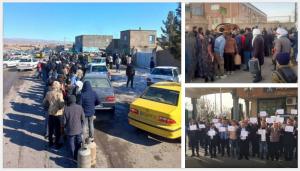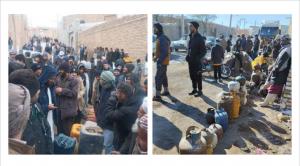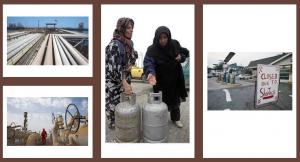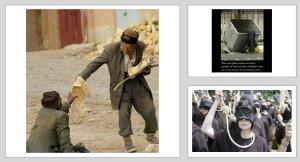(Video) Gas shortage Affect Iran’s uprising

Iran is experiencing an unprecedented gas crisis, crippling most of the country. Many industrial and educational centers in nearly 20 provinces are closed, so it is a harsh winter. How could Iran as the second-largest natural gas country face this crisis.

The regime’s engineered statistics indicate that five provinces face low gas pressure. But the reality is that this crisis expands across Iran. In many areas which lack gas piping, locals have to stand in lines for hours to get a gas capsule.

As always, the ruling theocracy blames people and their “high usage” for the current gas crisis. Authorities blatantly tell people to wear more warm clothes, turn off heating devices for at least six hours a day, and only use heaters in one room.
Iran’s gas infrastructure is seriously damaged, and it will take billions of dollars of investments and years of work to increase the gas production rate.
The recent closures due to the gas crisis have caused many people’s basic needs to be scarce. For example, many bakeries are closed or bake bread once or twice a day. Therefore, besides enduring cold nights, many Iranians must wait in long lines in freezing temperatures to get a loaf of bread.
The regime’s engineered statistics indicate that five provinces face low gas pressure. But the reality is that this crisis expands across Iran. In many areas which lack gas piping, locals have to stand in lines for hours to get a gas capsule.
As always, the ruling theocracy blames people and their “high usage” for the current gas crisis. Authorities blatantly tell people to wear more warm clothes, turn off heating devices for at least six hours a day, prevent the home’s temperature from passing 18 Celsius, and only use heaters in one room.
The kleptocracy in power has also used this opportunity to further plunder people’s wealth by increasing the price of gas by 30 to 50 percent for the so-called “high-usage households.”
In other words, the regime tells people who lack proper heating devices and other necessities in winter to shiver and tolerate the unbearable cold weather, or they will be charged!
Tehran also claims that since importing gas from Turkmenistan has ended, the current gas crisis has aggravated. This is another lie, as the volume of gas in the swap contract with Turkmenistan is 5 to 6 million cubic meters per day.
This amount does not count compared to the country’s gas consumption, which is 600 to 700 million cubic meters per day. Besides, it is an embarrassment for a government that claims it can cripple the European countries’ economy by seizing exporting gas to it.
The regime also claims that the unprecedented cold in winter has indeed surprised the officials. This is yet another blatant lie because the authorities were aware of the current situation, and many state-affiliated experts had warned about an impending gas crisis.
“Officials’ ignoring of the gas shortage will cause a severe disruption of the people’s heating systems, and devices, a 70% reduction in the country’s electricity production, the closure of basic industries and some public services such as bakeries and water distribution, and the emergence of general dissatisfaction,” Parliament’s Energy Commission warned on November 1, 2022, according to the state-run Bahar News website.
Iran’s exploitation infrastructures are seriously damaged, and it will take billions of dollars of investments and years of work to increase the gas production rate.
“By preventing wasting 100 million cubic meters of gas in the extraction process due to mismanagement and lack of planning, it is possible to supply the gas needed by at least 11 million Iranians in the harsh winter,” the state-run Chand-Sanieh website quoted Kaveh Madani, Iran’s former Deputy of Environmental Organization.
In 2021, Bijan Namdar Zangeneh, Hassan Rouhani’s Minister of Oil, warned about the gas shortage crisis in Iran, acknowledging that “If we fail to attract foreign investors, we will face serious problems.”
But considering a foreign investment in Iran’s gas sector is an unattainable solution. Because this investment is costly, some estimate it to take billions of dollars.
Above all, the regime’s corruption and oppression have caused colossal capital flight. Tehran’s international isolation due to its terrorism and warmongering policies doesn’t leave any room for possible foreign investment.
In November, in response to a parliamentary question about the gas sector, Ebrahim Raisi’s oil Minister Javad Owji said: “We need $80 billion to invest in the gas sector.”
“Do you think we have such an amount of money to resolve the gas crisis,” Mohammad Bagher Qalibaf, the parliament’s speaker, promptly acknowledged in Owji’s response.
Despite having a damaged energy infrastructure, Iran has enough gas to support its citizens. Authorities have constantly bragged about sending fuel to neighboring countries, especially Lebanon, where Hezbollah, Tehran’s terrorist proxy group, has a role in the government.
“Whenever the officials in Beirut declare their readiness, Tehran will be ready to help,” Hossein Amir-Abodllahian, the regime’s Foreign Minister, said on January 14, according to the state-run Khabar-online website.
The regime has been exporting Iran’s natural gas abroad, leaving very little for people to consume. One of many outcomes of Tehran’s disastrous policies is enduring a cold winter.
Since the clerical regime ships most of Iran’s high-quality gas to countries like Lebanon, the country’s power plant use fuel oil (mazut), a highly air-polluting substance. Hundreds of Iranians died in the summer due to polluted air, creating acute respiratory problems.
When faced with protests by people, the regime decreased using the fuel oil, only to increase power blackouts. Many Iranians infected with Covid-19 died in Intensive Care Units, as their oxygen machines were shut down in constant blackouts.
It is worth noting that much like gas, most of the electricity produced in Iran was transferred to Iraq, leaving very little for Iranians in a hot summer and amid the Covid-19 crisis.
Despite seeing people’s deplorable conditions, authorities blatantly invite people to modest consumption of energy.
“People should endure the gas crisis until 2039 if the situation continues as it is,” Ahmad Zeraat Kar, Head of the Energy Bureau of the Program and Budget Organization, said on January 2, according to the state-run Etemad daily.
But after four months of an incessant uprising, Iranians wouldn’t endure any crisis. “We have a terrible economic perspective. We also have a perilous situation on the international scene due to the recent execution of protesters.
The threat of the system’s situation becoming a security matter is very serious. In such a situation, the system faces economic, political, security, and international isolation, and this would be the beginning of our downfall, which I hope would never come,” Mohammad Sadr, a member of the regime’s Expediency Council, warned his peers on January 14, according to the state-run Etemad Online website.
Shahin Gobadi
NCRI
+33 6 61 65 32 31
email us here
On Jan. 17, the people of Torbat-e-Jam in North East of Iran held a protest in front of the local governorate The protest took place in the freezing winter.
Legal Disclaimer:
EIN Presswire provides this news content "as is" without warranty of any kind. We do not accept any responsibility or liability for the accuracy, content, images, videos, licenses, completeness, legality, or reliability of the information contained in this article. If you have any complaints or copyright issues related to this article, kindly contact the author above.


